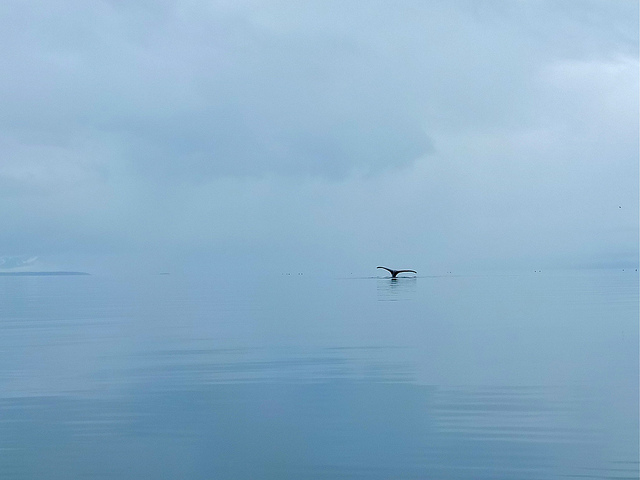
Whales are great. You can get a bunch of people who you thought were grumpy and walking by themselves along the sidewalk, and suddenly there’s a whale and you are all shouting and grinning at each other and most of the people have even hung up their phones or stopped texting or tweeting about how they’re taking a walk right now. Maybe you are all now trying to use your phones to take a photo of something that is a tiny ephemeral exhale on the horizon but that’s okay. Trying to capture the ephemeral is what art is, right? And talking to people you don’t know about whales is good. And the whales, the whales are great.
What is it that makes them so great? Many things, but today I was thinking about the elegance of their big bodies, the surprise of when it slides up into the open air like a glimmer of island on an empty sea. I was thinking so much about the whales that suddenly I started to feel guilty because I could have gone to my son’s field trip to the fire station instead of seeing whales and then puttering around the kitchen, thinking about seeing whales.
But it is hard to let go of a whale once you’ve seen it, hard to stop looking for it to appear again. Earlier that morning I had pointed to the spot where I’d seen a column of white spout against the green water and tried to yell to my friends: “Whale!” It is not so different with firetrucks. Even before I had kids, I’d want to point to the trucks and shout when I saw them–the long, elegant hook-and-ladders, the workaday engines, the sturdy tanker truck—gliding by. There’s almost the same feeling when I see them—a silence, a catch in the throat. I’m not sure if it is knowing that the truck is going to an emergency, or just the strange grace of it, this large thing moving through the streets. When the engine lights are on and people pull over to the side of the road, I often feel a similar moment of connection with everyone around me, even though it’s less celebratory. For a moment, we will watch and wait and allow.
A truck driver shot a video of a ladder truck—those extremely long trucks with a tiller driver in the back—crossing four lanes of freeway. It looks like a dance. Part of the beauty is that rear axle doing what it’s supposed to do, but another part of the beauty is the color, the red that seems so essential to this machine and to this moment that we call it fire engine red.
Fire trucks come in other colors, too: chartreuse and white and green. For a while, there was a movement away from red trucks, as people realized that the cones in the human eye, which help us see color, don’t work well at night; the eye can see shades like green and yellow better during dimmer light. A series of studies in the 1990s pointed to an increased number of visibility-related accidents for red firetrucks compared to lime, yellow and white trucks, and a 2009 study by the U.S. Fire Administration suggested that fluorescent shades are more visible than red in the daytime. Fire departments began to change the color of their trucks to help make the trucks, and their firefighters, more visible.
But the USFA report also said that people’s ability to recognize a fire truck mattered more than what color it was. Red trucks have made a comeback, with better reflective striping for increased visibility.
To a whale, it wouldn’t matter whether trucks were red or green. Whales and other marine mammals don’t have S-cones, which are sensitive to short wavelength, blue light. Baleen whales, like the humpbacks I saw this morning, may have also lost the function of the L-cones, which gather red-green, medium-to-long wavelength light. To them, the ocean is a rainbow of grays.
In a 2013 story for The Atlantic, Alexis Madrigal writes about an even more complicated aspect of a whale’s eyes. Our eyes have a single area on the retina called the fovea centralis, where the cones are packed together, creating hi-res images for our brain to ponder over. Each of the whale’s eyes have two areas where photoreceptors huddle together. These two areas of focus stay open even the whale’s pupil narrow “like a smiling mouth,” Madrigal writes. One eye on each side of the head, each with two perspectives, each searching through the grays and the blacks of the world beneath the sea.
Right now, the humpbacks are seeing the coast as they head north. Today it was a mother and a baby, the mother about 300 yards offshore, the baby edging closer. We were surfing and suddenly forgot all about the waves and were grinning like fools in the cold water. If I had a phone I would have taken a picture of it all, the glassy water, the white teeth, the distant rise of whales, those dark islands in all the brightness. I wouldn’t care if it was in grayscale. Because there were sirens, too, singing in the water and back on land, making us stop for a moment and notice the large things that move among us.
*
Image by Flickr user Joseph under Creative Commons license (3/14/19)
Holy crap! Whales see in stereo with EACH EYE?!? How cool is that!
Dr. D, right?!?!? My head hurts trying to imagine it.
In awe of giants and this author!
Great article Cameron!
So creative. Whales and fire trucks, who else could have juxtaposed those in one post. Loved it.